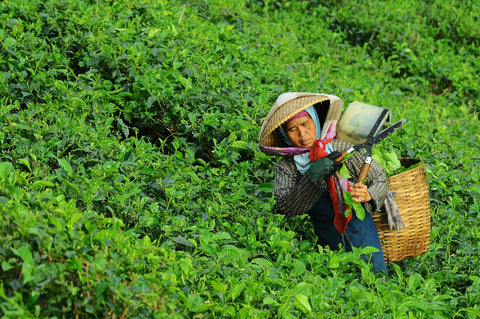









08 November 2018 by Roy Preece

Oolong tea is halfway between green tea and black tea. Black tea, what we often think of as English tea, is made by blowing air over the dried leaves to oxidise them; but Oolong tea is not oxidised so much and unlike black tea is usually taken without added milk, like green tea.
Taiwan produces very fine Oolong tea. The short clip in this video shows tea leaves being harvested in the beautiful Alishan Hills in Taiwan to be made into Oolong tea, and how it is best prepared for drinking to produce the best flavour. Tradition shows the best way, in England as well as in Taiwan.
In England we have customs too. It is always said that the best tea is made in a brown pot. It’s difficult to think of a logical reason for this, except that brown teapots are always thick and chunky and maybe they retain heat better, but are not perhaps so elegant. Even worse, I remember the disappointment of one lady from Taiwan, eager to experience her first traditional English cream tea, when the tea was served in a stainless-steel pot. People used to have pretty, home-made, knitted ‘tea cosies’ to keep the tea warm, too, as they sat around talking and drinking the tea.
It’s important to warm the pot first, so we fill the pot with very hot or boiling water -- and then tip it out again. (When old people do this these days they are sometimes thought to be absent minded!) In the days before tea bags, when tea was loose and kept in a tin tea ‘caddy’, the rule was ‘one spoonful for each person and one for the pot. In Taiwan they cover the bottom of the pot. In the eighteenth and nineteenth centuries, when tea was expensive, tea caddies were beautifully made wooden boxes with locks and keys. These are now desirable antiques.
Most people use boiling water for black tea (I do), but some say it should be only 90-95 degrees C. The tea should then soak or ‘steep’ for about one minute (in Taiwan they count to 50, which is about the same). A few people, usually active men like servicemen or builders, like their tea ‘stewed’ and very strong, leaving it for maybe four or five minutes to make it so strong they say that ‘the spoon will stand up in the teacup! Perhaps this habit follows from the way tea was prepared for large numbers of people by being brewed in a large pot or ‘tea urn’ and served over a long time. I remember at one research station where I worked, when several of us would gather to have tea, an ex-naval officer always waited several minutes after the rest of us to pour his tea.
Then there’s the vexed question of whether to put the milk in the cup first or last, which we will avoid for now! If the tea was properly made the tea leaves mostly sank to the bottom of the cup, although they could be avoided altogether with use of a tea strainer when pouring the tea. Certain people claimed to be able to ‘read the tea leaves’; that is, they would tell your future by interpreting the pattern of leaves left in the cup, which added interest to a tea party.
In England we don’t think of having a ‘tea ceremony’. But there was a good deal of custom involved in the enjoyment of tea in a social setting, which has been largely lost. Today we are as likely to be served with a teabag put directly in a cold cup with some ‘warm’ water to add, but that doesn’t make a satisfying cup of tea at all, and we have largely lost a simple pleasure.